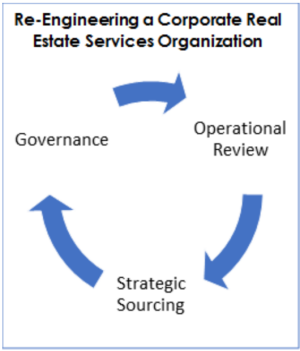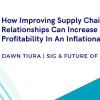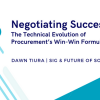Although these processes can take months – sometimes longer, the work does not end when the contract is signed or even when the services are successfully transitioned to the outsourced partner. You don’t simply hand over responsibility for the contracted services, schedule quarterly and annual updates and expect things to run smoothly.
In the final segment of this series, we will examine the complex collection of topics related to governance, as well as some of the tools that support the implementation of a comprehensive supplier performance management strategy, including:
- Relationship Management Training
- Communications Strategy
- Escalation Processes and Procedures
- Performance Management
- Governance Support Platforms
- Periodic Relationship Health Checks and Contract Reviews
Relationship Management Training
Careful preparation is critical as you transition from the strategic sourcing phase into the operational phase, and training for both client and supplier stakeholders must be part of the transition. There should be initial training, of course, but don’t overlook the need for ongoing training as well as training for new hires.
Training should, at minimum, cover the following topics:
- All aspects of the deal itself
- Deal intent
- Performance management components
- Communication expectations and escalation procedures
- Review of governance support platforms in use
- Relationship management
- Ongoing strategy of refresher training programs for existing employees and onboarding of new employees
Communication Strategy
An effective communication strategy is essential to maintain alignment between the parties over time and establish a strong foundation for trust. A successful communications strategy will establish time-frames and cadence for formal communication for all stakeholders; foster open and honest communication; and establish expectations for bi-directional communication based on facts.
Guidelines for Formal Communication
Establish clear minimum guidelines for the type and frequency of communication. Special consideration should be given to the need for cross-functional communication, inter-departmental communication and communication between the contract parties.
Open and Honest Communication
Frequency of communication is important, but the quality of communication is even more critical. While management gurus have written entire books on the topic, there are a couple of basic things to keep in mind.
First, even though the client and supplier are two separate organizations, it should be made clear that all the stakeholders and participants in the relationship are part of the same team, and the relationship is not a zero-sum game.
Second, open and honest communication should be respected and valued, regardless of whether the communication is related to successes, challenges or even a crisis.
Communicate with Facts
Communication should be fact-based. Beware of conversations based on opinions, hunches, or hearsay. Set the expectation among all stakeholders that verifiable facts or metrics support any claims, whether related to successes or shortcomings.
Escalation Processes and Procedures
In instances where normal lines of communication fail to resolve performance issues, conflicts or misunderstandings, clear processes and procedures must be in place for escalation and resolution of the issues. At a minimum, these policies and procedures should:
- Identify the process for each stage of escalation and each category of issue
- Identify the appropriate individual to contact
- Identify the information that should be provided
- Identify the appropriate time-frame for response
- Identify the process for communicating the outcome back to the stakeholders
Performance Management
Throughout a strategic sourcing initiative, great care is taken to develop a sound and mutually beneficial contract that specifies all the tools necessary to support a strong performance management program. The most effective contracts include the following elements.
Outcome-Based Service Level Agreements (SLAs)
A well-constructed SLA sets the stage for clear client and supplier expectations, and includes:
- A clear definition of the function to be performed
- A specific list of responsibilities related to the function
- Expectations regarding workload volumes
- Time-frames in which work is expected to occur
- Clearly stated expectations of service levels and performance levels
Performance Based Specifications
The SLAs focus on the needs of the company and service levels required, but should not address the specific process used to perform the service or attain the specified service level. This is important for several reasons:
- The client is outsourcing to take advantage of the expertise of the supplier.
- If the client specifies how work will be done, it is in effect taking on the role of employer and may be held responsible for employee benefits and liabilities related to the work of the supplier’s employees.
- Locking in a specific process may preclude the supplier from applying new innovations that could bring significant benefit to the client.
At-Risk Fee Structure
In a typical at-risk compensation strategy, the supplier places a portion of their management fee at risk. This percentage is held back from each payment until the end of the quarter, year or other appropriate review period. Based on the metrics and scorecard specified in the contract, the client will pay the percentage of at-risk compensation due based on the supplier’s performance for the period.
Shared Saving Incentive Program
Shared saving incentive programs encourage suppliers to find additional ways to reduce costs associated with the services provided. Savings are shared between the supplier and client according to a predetermined percentage on a quarterly or annual basis.
Performance Measures
Well-defined performance measures help suppliers understand exactly what is expected of them and how their performance will be judged. Key Performance Indicators (KPIs) are quantifiable performance measures that will be used to indicate the level of success of the supplier in meeting the goals and objectives of their contractual relationship.
Communication and Feedback
SLAs should contain reporting requirements and performance-based expectations regarding frequency and method of communication. At-risk compensation models should require both the supplier and client to provide timely feedback. This is particularly important when performance issues are identified. After all, your goal is that the performance of both parties results in:
- Services delivered at the expected level of quality and consistency
- 100% of the anticipated compensation for the supplier
- Ongoing realignment of the objectives of the client with the goals of the supplier
Governance Support Platforms
A robust and reliable governance support platform is essential to ensure that scorecards are generated on a timely basis, that reporting and benchmarking are timely and insightful and that you don’t get bogged down in the minutiae of aggregating metrics, statistics and other data from multiple sources and departments across the enterprise.
A good platform supports sound governance through:
- Ensuring consistency in data collection and alignment with established performance measures
- Delivering standardized reporting in consistent formats
- Creating and storing a complete record and history of all interactions
- Providing a common platform for communication and issue escalation
- Securing data and sensitive information with multiple security levels and access
In addition, these platforms allow access using a variety of devices, from the traditional desktop or laptop to tablets and smart phones.
Periodic Relationship Health Checks and Contract Reviews
Beyond the structured aspects of relationship management and governance, periodic review and health checks can provide deeper strategic insight into critical success factors, underlying structural misalignments or fundamental changes in the contextual environment that may be eroding value. Some of the different tools that can help uncover challenges and opportunities are described below.
Compatibility and Trust Assessment (CaTTM)
The Compatibility and Trust Assessment was developed by Gerald Ledlow Ph.D. and Karl B. Manrodt Ph.D. to measure the strength of an existing business relationship between two parties. A key outcome of the CaT is to document organizational maturity across five key dimensions: trust, innovation, communication, team orientation and focus. It provides an overall “raw score” and highlights “perception gaps” between the parties. This tool can be a powerful support in improving the relationship between supplier and client.
Relationship Health Check
A relationship health check looks at several different aspects of the relationship between client and supplier, including communications, decision-making, governance, innovation, metrics, mindset and trust, performance and problem-solving. The resulting report helps both parties understand the relative health of the strategic relationship, and flags potential problems and problem areas. The summary findings identify opportunities for action plans or contract modifications that address gaps and concerns.
A Standing Neutral – Relationship Facilitation
Where the CaT and relationship health check offer point-in-time assessments of a strategic business relationship, a “standing neutral” contributes to the strength of a relationship over time. The concept begins with the understanding that no contracts are perfect, and that unanticipated situations, interpretations or disputes are bound to happen. At the beginning of the relationship, both parties approve a neutral third party to stand ready to intervene when called upon at any time throughout the life of the relationship.
The standing neutral works as a moderator or arbitrator, but with a critical difference. Having been appointed at the beginning of the contract, before an issue or dispute arises, the standing neutral is involved as part of the governance mechanism. Parties to the contract utilize the standing neutral earlier as issues arise, and before they erupt into disputes or lawsuits.
Contract/Deal Review
The contract/ceal review is a detailed review of the contracts, exhibits, processes and governance activities of the relationship to assess:
- The relevant artifacts relative to the original intent of the deal if known
- The current desired objectives and vision for the relationship
- Market benchmarks and other benchmarks to specific deal strategies
The review helps stakeholders to see the structural flaws in their relationship from a contractual perspective and identifies what needs to be done in order to close those gaps and strengthen the relationship going forward.
This completes our series, Re-Engineering a Corporate Real Estate Services Organization, which touched briefly on the long list of complex topics involved in a process that, when done correctly, can yield outstanding results, process improvements, innovation and savings. But the sheer scale and complexity of the process when undertaken on an enterprise scale, means that there are a multitude of opportunities for things to go awry. Hundreds of millions of dollars and the operational integrity of the business hang in the balance.
The key to success is ensuring that the right resources with the necessary experience are put in place and given the level of support they require. Understand the strengths and weaknesses of your organization, the motivations of the stakeholders, and the likely pitfalls, then plan accordingly. Reinforce your team with outside resources and experienced or neutral third parties wherever it is likely to improve your chances of success. Your investment in excellence will pay off in the long run.










